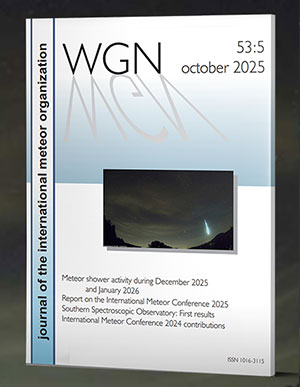No matter where you live, the first half of
December provides some of the best meteor activity of the year. In the northern
hemisphere the sporadic rates are still strong plus you can also count on strong
activity from the Geminids, which peak on December 13. There are also several
minor radiants that add a few meteors each hour. All of these centers of activity
are located high in the sky during the early morning hours this time of year.
As seen from the southern hemisphere the sporadic rates are increasing
toward a January maximum. Shower rates are also good but the Geminids suffer
a bit from the lower elevation seen from southern locations. Still with the
warmer weather now occurring south of the equator, December is a great time
to view celestial fireworks.
During this period the moon reaches its full
phase on Friday December 12th. At this time the moon will be in the sky all night
long, overpowering the fainter meteors. This weekend the waxing gibbous moon will
set during the early morning hours allowing several hours of dark sky viewing
before the onset of morning twilight. The estimated total hourly rates for evening
observers this week is near four for those located in the mid-northern hemisphere
(45 N) and two for those viewing from the mid-southern hemisphere (45 S). For
morning observers the estimated total hourly rates should be near twenty five for those
located in the mid-northern hemisphere (45 N) and twenty for those viewing from
the mid-southern hemisphere (45 S). Locations between these two extremes would see
activity between the listed figures. These rates assume that you are watching from
rural areas away from all sources of light pollution. The actual rates will also
depend on factors such as personal light and motion perception, local weather
conditions, alertness and experience in watching meteor activity. Evening rates
are reduced due to the bright moonlight.
The radiant positions and rates listed below are exact
for Saturday night/Sunday morning December 6/7. These positions do not change
greatly day to day so the listed coordinates may be used during this entire period.
Most star atlases (available at science stores and planetariums) will provide maps
with grid lines of the celestial coordinates so that you may find out exactly where
these positions are located in the sky. A planisphere or computer planetarium program
is also useful in showing the sky at any time of night on any date of the year.
Activity from each radiant is best seen when it is positioned highest in the sky,
either due north or south along the meridian, depending on your latitude. It must
be remembered that meteor activity is rarely seen at the radiant position. Rather
they shoot outwards from the radiant so it is best to center your field of view so
that the radiant lies at the edge and not the center. Viewing there will allow you to
easily trace the path of each meteor back to the radiant (if it is a shower member)
or in another direction if it is a sporadic. Meteor activity is not seen from radiants
that are located below the horizon. The positions below are listed in a west to east
manner in order of right ascension (celestial longitude). The positions listed first
are located further west therefore are accessible earlier in the night while those
listed further down the list rise later in the night.
The following showers are expected to be active this week:
The Phoenicids (PHO) are a periodic shower that rarely produces noticeable
activity. The only impressive display produced by this shower occurred in
1956 when ZHR’s were near 100. Peak activity occurs on December 6. Little
activity is expected away from the peak night. The radiant is currently
located at 01:16 (019) -53. This position lies in southeastern Phoenix some
four degrees northwest of the bright zero magnitude star Achernar (Alpha
Eridani). These meteors are best seen near 2100 (9pm) local standard time
(LST, regardless of time zone) when the radiant lies highest above the
horizon in a dark sky. Due to the southerly declination of the radiant, this
shower is not visible north of the northern tropical areas. The deep
southern hemisphere has the best chance of seeing any activity. At 22
km/sec. the Phoenicids produce very slow meteors.
The Earth has now passed the stream of particles produced by comet 2P/Encke,
which gives us the Taurid meteors each autumn. As we enter the month of
December we again recognize the ever present Antihelion (ANT) radiant.
This large, diffuse radiant is now centered at 05:44 (086) +23. This position
lies in eastern Taurus, six degrees southeast of the second magnitude star El
Nath (Beta Tauri). This area of the sky is best placed on the meridian near
0100 LST. One can expect to see approximately three shower members per hour as
seen from the northern hemisphere and two per hour from south of the equator. At
30km/sec., the average Antihelion meteor travels slowly through the skies.
Monocerotid (MON) activity begins and peaks this weekend. The radiant is located
at 06:32 (098) +09. This area of the sky is located in northern Monoceros, seven
degrees northeast of the first magnitude star Betelgeuse (Alpha Orionis). These
meteors are best seen near 0100 LST when the radiant lies highest above the
horizon. The peak for the Monocerotids occurs on Sunday December 7th. Rates then
slowly decline until the activity ceases near December 20th. This shower
would be equally well seen from both hemispheres. Current rates are most
likely near two per hour. At 42 km/sec. the Monocerotids produce meteors of
average velocity. Do not confuse this radiant with the nearby November Orionids
(located eight degrees north),the Antihelion radiant located fifteen degrees
to the northwest, and the Geminids located twenty degrees to the northeast. One
must face toward these radiants for any hope of properly classifying them.
Sirko Molau’s study of video radiants has shown that there is an active radiant
located in northeastern Orion this time of year. The radiant is currently located
at 6:40 (100) +17. This position lies in that portion of the sky occupied by the
second magnitude star Alhena (Gamma Geminorum). Current rates should be near one
shower member per hour. These meteors are best seen near 0200 LST when the radiant culminates
on the meridian. At 45 km/sec. the November Orionids (NOO) produce meteors
of medium-swift velocity. This shower
has a very similar radiant position with the better known and much more active
Orionids (of October and early November). Last year I called these the Lambda
Orionids, not knowing the IAU had already listed a designation for this shower.
Currently the Geminids (GEM) should be producing two meteors per hour from a radiant
located at 07:00 (105) +33. This position lies in northwestern Gemini, eight
degrees west of the second magnitude star Castor (Alpha Geminorum). Toward the
end of the week rates should increase to near five per hour as seen from the
northern hemisphere. These meteors are best seen near 0200 LST when the radiant
lies highest above the horizon in a dark sky. At 35 km/sec. the Geminids produce
mostly medium speed meteors.
The Puppid-Velids (PUP) is a vast complex of weak radiants located in the
constellations of Puppis and Vela. Visual plots and photographic studies
have revealed many radiants in this area during November and December. The
combined strength of these radiants can produce a ZHR of ten. Actual hourly
rates will be much less unless you happen to be observing from the deep
Southern Hemisphere. The center of this activity is currently located at
08:08 (122) -45. This position lies in eastern Puppis, two degrees north of
the second magnitude star Gamma Velorum. Peak rates occurred near December 6.
These meteors are best seen near 0300 LST when the radiant lies highest
above the horizon in a dark sky. Observers located in the Southern
Hemisphere have an advantage viewing this shower as the radiant will rise
higher into their sky allowing more activity to be seen. At 40 km/sec. the
Puppid-Velids produce meteors of average velocity.
The Sigma Hydrids (HYD) are active from a radiant located at 08:12 (123)
+03. This position lies in eastern Canis Minor, seven degrees southwest of the
zero magnitude star Procyon (Alpha Canis Minoris). These meteors are best seen
near 0400 LST when the radiant lies highest above the horizon in a dark sky. At
60 km/sec. the Sigma Hydrids produce mostly swift meteors.
Activity from the Coma Berenicids (COM) are just now beginning to appear. Hourly
rateswould be less than one this week from a radiant located at 10:00 (150) +36.
This area of the sky is located in central Leo Minor. The easiest way to pinpoint
this area of the sky would be to look fifteen degrees north of the “sickle” of
Leo. This radiant is probably responsible for the many reports of activity in Leo
during the month of December. These meteors are best seen near 0500 LST when the
radiant lies highest above the horizon. At 64 km/sec. the Coma Berenicids
will usually produce meteors of swift velocity.
The Chi Virginids (CVR) were discovered during Sirko Molau’s study of video
radiants. Activity is first noticed on December 11th and the best rates occur a
night later. The radiant is located at 12:20 (185) -08. This position lies in
southwestern Virgo, eight degrees north of the third magnitude star Algorab (Delta
Corvi). These meteors are best seen during the last dark hour before the start of
morning twilight when the radiant lies highest above the horizon in a dark sky. At
69 km/sec. the Chi Virginids produce mostly swift meteors.
As seen from the mid-northern hemisphere (45N) one would expect to see approximately
sixteen Sporadic meteors per hour during the last hour before dawn as seen from
rural observing sites. Evening rates would be near three per hour. As seen from the
mid-southern hemisphere (45S), morning rates would be near ten per hour as seen
from rural observing sites and one per hour during the evening hours. Locations
between these two extremes would see activity between the listed figures. Evening
rates are reduced due to the bright moonlight.
The table below presents a summary of the expected activity this week. Rates and
positions are exact for Saturday night/Sunday morning but may be used all week.
| SHOWER | DATE OF MAXIMUM ACTIVITY | CELESTIAL POSITION | ENTRY VELOCITY | CULMINATION | HOURLY RATE | CLASS* | RA (RA in Deg.) DEC | Km/Sec | Local Standard Time | North-South | Phoenicids (PHO) | Dec 06 | 01:16 (019) -53 | 22 | 21:00 | <1 - <1 | III | Antihelion (ANT) | – | 05:44 (086) +23 | 30 | 01:00 | 3 – 2 | II | Monocerotids (MON) | Dec 07 | 06:32 (098) +09 | 42 | 02:00 | 2 – 2 | II | November Orionids (NOO) | Nov 28 | 06:40 (100) +17 | 45 | 02:00 | 1 – 1 | IV | Geminids (GEM) | Dec 13 | 07:00 (105) +33 | 35 | 02:00 | 2 – 1 | I | Puppid-Velids (PUP) | Dec 06 | 08:08 (122) -45 | 40 | 03:00 | 1 – 5 | II | Sigma Hydrids (HYD) | Dec 09 | 08:12 (123) +03 | 60 | 03:00 | 1 – 1 | II | Coma Berenicids (COM) | Dec 20 | 10:00 (150) +36 | 64 | 05:00 | <1 - <1 | II | Chi Virginids (CVR) | Dec 12 | 12:20 (185) -08 | 69 | 07:00 | <1 - <1 | IV |




 You saw something bright and fast? Like a huge shooting star? Report it: it may be a fireball.
You saw something bright and fast? Like a huge shooting star? Report it: it may be a fireball.  You counted meteors last night? Share your results with us!
You counted meteors last night? Share your results with us!  You took a photo of a meteor or fireball? You have a screenshot of your cam? Share it with us!
You took a photo of a meteor or fireball? You have a screenshot of your cam? Share it with us!  You caught a meteor or fireball on video? Share your video with us!
You caught a meteor or fireball on video? Share your video with us!